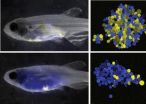(Press-News.org) In the tropical highlands of South America and East Africa, cool temperatures have historically kept mosquito-borne diseases, such as malaria, at bay. New research by Howard Hughes Medical Institute (HHMI) scientists shows that as annual temperatures rise in these areas, malaria can spread to populations in higher elevations that had historically not been at as much risk of being infected by malaria parasites.
HHMI scientists have compared the yearly distribution of malaria cases in two mountainous regions in South America and East Africa, and found that in warmer years, populations at high elevations experience more infections than they do in cooler years. Their findings, published March 7, 2014, in the journal Science, suggest that without increased control measures, climate change will increase the burden of malaria, particularly in areas that are densely populated at higher elevations.
"The pattern is very clear, and the implication is that warmer temperatures cause an expansion in altitudes [where malaria infections occur]," says Mercedes Pascual, an HHMI investigator at the University of Michigan who led the study. "Long-term trends should see an increase in cases as the disease both expands to higher altitude and causes more cases at higher altitudes."
Temperature has long been known to affect the spread of malaria. The mosquito that transmits the malaria-causing parasites, Plasmodium falciparum and Plasmodium vivax, thrives at warmer temperatures. Furthermore, the parasite itself matures into its infectious form more rapidly when temperatures are high. Still, Pascual says, scientists have lacked direct evidence that increasing temperatures would permit the parasite to encroach on new territory. Some scientists have also argued that socioeconomic change and associated control measures might outweigh the effects of climate change.
Malaria prevalence fluctuates over time in response to many factors, Pascual explains: changes in temperature, rainfall, land use, the parasite's resistance to antimalarial drugs, and mosquito-control measures all affect transmission of the disease. "When you're looking at long-term trends, it's difficult to attribute change to specific factors," she says.
So instead of analyzing long-term trends, Pascual and graduate students Mauricio Santos-Vega and Amir Siraj decided instead to compare malaria cases year-to-year, in two regions that had kept detailed records of the times and locations of infections. Working with colleagues at the University of London, the Oromia Regional Health Bureau in Ethiopia, and Columbia University in New York, they mapped the geographical distribution of malaria cases in the Antioquia region of western Colombia from 1990 to 2005 and the Debre Zeit area of central Ethiopia from 1993 to 2005 – before intense intervention efforts had begun. For each region, they analyzed how distribution along elevation gradients changed from one year to the next, then looked for statistical associations to fluctuations in annual average temperatures.
Their analysis showed that the distribution of malaria cases shifted to higher elevations in warmer years. When temperatures cooled, the distribution of cases retreated to lower elevations.
Pascual and her colleagues also used their analyses to consider the increasing prevalence of malaria in Antioquia and Debre Zeit during the 1980s and 1990s, and found that changing temperatures could account for those long-term trends. "In those decades, we are already observing an effect of climate change," says Pascual.
The impact of ongoing climate change will be large, she says. In Ethiopia alone, 37 million people live at altitudes of 1,600 to 2,400 meters (5,249 to 7,874 feet), the range the team analyzed in their study of Debre Zeit. In a previous analysis, Pascual and colleagues estimated that without control measures, an increase in 1 degree Celsius could cause an additional 3 million additional infections in children under 15 years old each year in that population.
"Now we have evidence that this shift to higher elevations does occur," she says. Furthermore, individuals living in regions where they have not previously been exposed to malaria are more vulnerable than those in endemic regions, who have often acquired immunity from prior infections to help fight off severe disease.
"This underscores the need to sustain interventions to mitigate the effects of climate change," Pascual says. Fortunately, she adds, malaria control strategies, such as insecticides, bed nets, environmental modification, and use of efficacious anti-malarial drugs, have a higher chance of success than at lower elevations, in these regions at the edge of the distribution of the disease, where transmission rates remain relatively low – even though those edges will shift as epidemic areas expand. Data from this study can be found at the Dryad Repository: doi:10.5061/dryad.dp78p.
INFORMATION: END
Warmer temperatures fuel spread of malaria into higher elevations
2014-03-06
ELSE PRESS RELEASES FROM THIS DATE:
Birds of all feathers and global flu diversity
2014-03-06
A group of international scientists have completed the first global inventory of flu strains in birds by reviewing more than 50 published studies and genetic data, providing new insight into the drivers of viral diversity and the emergence of disease that can ultimately impact human health and livelihoods.
The research, published in the journal PLOS ONE and performed as part of the USAID PREDICT project, identified over 116 avian flu strains in wild birds. This is roughly twice the number that were found in domestic birds, and more than ten times the number found in humans. ...
Returning vets face 'warring identities' distress
2014-03-06
PROVIDENCE, R.I. [Brown University] — Much of the research on post-combat mental health of veterans focuses on problems like post-traumatic stress disorder (PTSD) and major depression. A paper co-authored by R. Tyson Smith, visiting assistant professor of sociology, takes an even broader snapshot of returning soldiers' mental state by focusing instead on the identity conflict many face when transitioning from soldier to civilian life and how that conflict manifests as mental distress. The paper was published in the January issue of Society and Mental Health.
"You can't ...
Colored diamonds are a superconductor's best friend
2014-03-06
Flawed but colorful diamonds are among the most sensitive detectors of magnetic fields known today, allowing physicists to explore the minuscule magnetic fields in metals, exotic materials and even human tissue.
University of California, Berkeley, physicist Dmitry Budker and his colleagues at Ben-Gurion University of the Negev in Israel and UCLA have now shown that these diamond sensors can measure the tiny magnetic fields in high-temperature superconductors, providing a new tool to probe these much ballyhooed but poorly understood materials.
"Diamond sensors will give ...
Alzheimer's research team employs stem cells to understand disease processes and study new treatment
2014-03-06
Boston, MA – A team of Alzheimer's disease (AD) researchers at Brigham and Women's Hospital (BWH) has been able to study the underlying causes of AD and develop assays to test newer approaches to treatment by using stem cells derived from related family members with a genetic predisposition to (AD).
"In the past, research of human cells impacted by AD has been largely limited to postmortem tissue samples from patients who have already succumbed to the disease," said Dr. Tracy L. Young-Pearse, corresponding author of the study recently published in Human Molecular Genetics ...
E-cigarettes: Gateway to nicotine addiction for US teens, says UCSF study
2014-03-06
E-cigarettes, promoted as a way to quit regular cigarettes, may actually be a new route to conventional smoking and nicotine addiction for teenagers, according to a new UC San Francisco study.
In the first analysis of the relationship between e-cigarette use and smoking among adolescents in the United States, UCSF researchers found that adolescents who used the devices were more likely to smoke cigarettes and less likely to quit smoking. The study of nearly 40,000 youth around the country also found that e-cigarette use among middle and high school students doubled between ...
Up-converted radio
2014-03-06
Ever worry about losing your mobile-phone reception? The problem is a weak microwave signal. The same problem hampers cosmologists looking at the early universe, a glimpse embodied in the cosmic microwave background. Or take a pressing earthly example: oncologists often locate and identify tumors using MRI scans. All three of these efforts---communications, cosmology, medicine---depend on discriminating weak microwave or radio signals from a noisy environment. A new approach to this important problem provides a clean, all-optical detection of microwaves and radiowaves ...
Discovery sheds new light on marijuana's anxiety relief effects
2014-03-06
An international group led by Vanderbilt University researchers has found cannabinoid receptors, through which marijuana exerts its effects, in a key emotional hub in the brain involved in regulating anxiety and the flight-or-fight response.
This is the first time cannabinoid receptors have been identified in the central nucleus of the amygdala in a mouse model, they report in the current issue of the journal Neuron.
The discovery may help explain why marijuana users say they take the drug mainly to reduce anxiety, said Sachin Patel, M.D., Ph.D., the paper's senior ...
Some people really just don't like music
2014-03-06
It is often said that music is a universal language. However, a new report in the Cell Press journal Current Biology on March 6 finds that music doesn't speak to everyone. There are people who are perfectly able to experience pleasure in other ways who simply don't get music in the way the rest of us do.
The researchers refer to this newly described condition as specific musical anhedonia—in other words, the specific inability to experience pleasure from music.
"The identification of these individuals could be very important to understanding the neural basis of music—that ...
'Seeing' bodies with sound (no sight required)
2014-03-06
People born unable to see are readily capable of learning to perceive the shape of the human body through soundscapes that translate images into sound, according to researchers who report their findings in the Cell Press journal Current Biology on March 6. With a little training, soundscapes representing the outlines and silhouettes of bodies cause the brain's visual cortex—and specifically an area dedicated in normally sighted people to processing body shapes—to light up with activity.
With no more than 70 hours of training on average, study participants could recognize ...
Common mutation is culprit in acute leukemia relapse
2014-03-06
Harvard stem cell scientists have identified a mutation in human cases of acute lymphoblastic leukemia that likely drives relapse. The research, published in Cancer Cell, could translate into improved patient care strategies for this particular blood cancer, which typically affects children but is more deadly in adults.
In recent years, a trend toward single-cell analysis has shown that individual cells within a tumor are capable of amassing mutations to make them more aggressive and treatment resistant. So while 99% of a tumor may be destroyed by the initial treatment, ...



